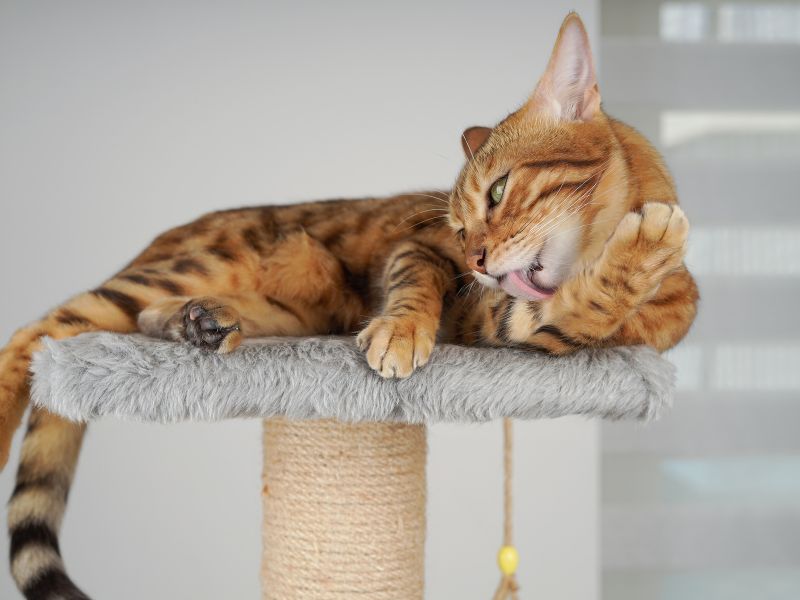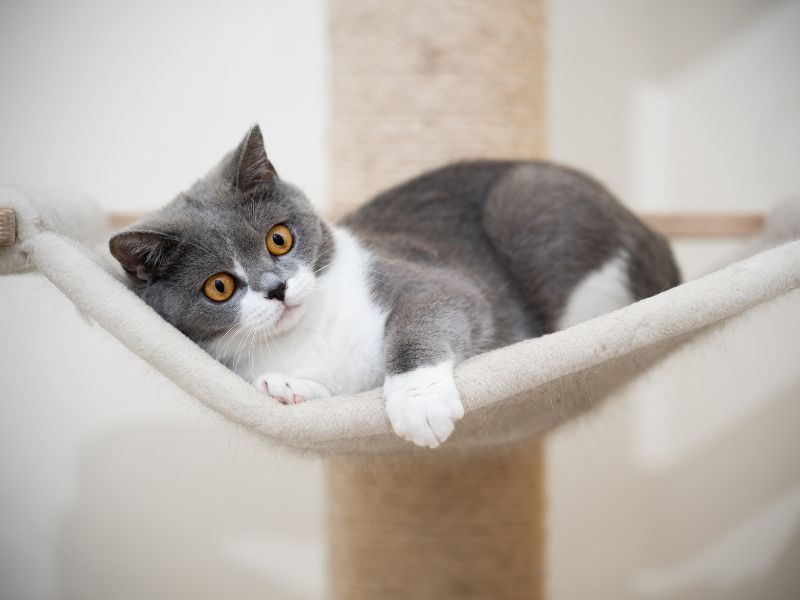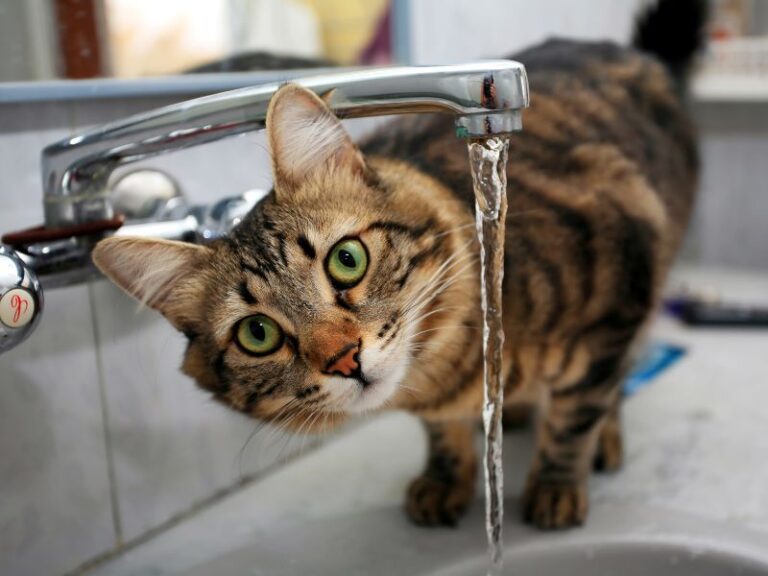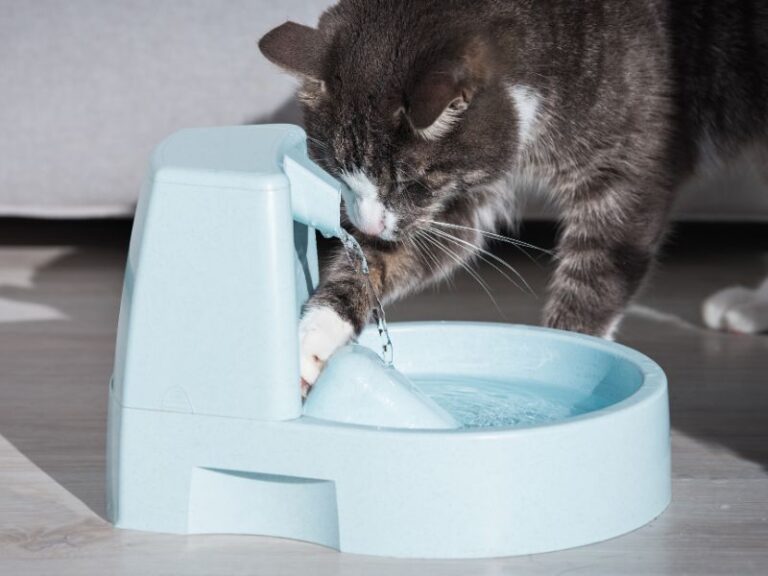Table of Contents
ToggleBringing a furry feline friend into your home can be a joyous experience. Cats, with their mysterious charm and playful antics, quickly find their way into our hearts. However, as much as we adore them, there’s one aspect of their behavior that can leave us scratching our heads – quite literally. Cats have an innate need to scratch, and they’re not shy about expressing it on our furniture, carpets, and curtains. But fear not! There’s a simple and effective solution to keep your furniture intact and your cat content – the cat scratching post.
Benefits of a Cat Scratching Post
- Natural Instincts: Scratching is inherent in cats, serving to sharpen claws, stretch muscles, and mark territory. A cat scratching post provides a safe space for them to indulge in these instincts.
- Stress Relief: A scratching post acts as a stress reliever, offering a familiar and comforting outlet for cats to unwind and release pent-up energy.
- Furniture Savior: Placing a cat scratching post diverts their attention from furniture, saving it from scratch marks and damage.
- Exercise and Play: Scratching provides exercise and mental stimulation, keeping cats physically active and engaged.
- Bonding Opportunity: Building a DIY cat scratching post becomes a delightful bonding experience between you and your cat, creating something special for your feline companion.
Why Every Cat Needs a Cat Scratching Post?
A cat scratching post is essential for a cat’s well-being, protecting furniture and promoting a happier lifestyle. DIY construction adds a personal touch, making it special for your furry friend.
Understanding Your Cat’s Scratching Behavior
Cat scratching is a captivating and puzzling behavior that holds intriguing mysteries. It may appear mischievous, but understanding their instincts reveals the true reasons behind this behavior.
Why Cats Scratch
- Marking Their Territory: Scratching leaves pheromones, communicating and claiming territory among cats.
- Keeping Claws Sharp: Scratching sheds outer claw sheaths, maintaining sharpness for hunting or defense.
- Stretching Muscles: Scratching allows cats to stretch and flex their muscles for suppleness.
- Stress Relief: Scratching helps cats cope with stress and release pent-up energy.
Discuss the Significance of a Suitable Scratching Post
- Satisfies Natural Instincts: Scratching post fulfills a cat’s innate need to scratch, embracing their instincts freely.
- Stress Reduction: Ideal post acts as a stress-reliever, providing a secure retreat in multi-pet households or during environmental changes.
- Protects Furniture: Dedicated scratching surface safeguards furniture from claw marks.
- Promotes Physical Activity: Sturdy post encourages play, climbing, stretching, and muscle engagement.
- A Place to Call Their Own: The post becomes a cat’s territory and a comforting spot they can claim as their own.
Materials and Tools Needed
Embarking on a DIY cat scratching post project is rewarding and budget-friendly. Before starting, gather all essential materials and tools for the pawsome construction. With the right supplies, you’ll create a scratching haven your cat will adore.
Materials Required
- Wooden Base: Sturdy and stable base, plywood or solid wood in square/rectangular shape.
- Sisal Rope: Cat’s dream texture for scratching, enough to cover the post length.
- Cardboard Tube: Large tube as the core of the scratching post.
- Carpet or Faux Fur: Durable and cat-friendly material to wrap around the tube.
- Wood Screws: For secure attachment of base and components.
- Brackets and L-Brackets: Reinforce joints for stability.
- Nails or Staples: Fasten sisal rope and carpet/fur to the base and tube.
- Wood Glue: Strengthens the bond between wooden parts.
- Catnip: Optional, sprinkle to attract your cat.
Tools Needed
- Saw: For cutting wooden components to desired dimensions.
- Drill: To create holes for screws and secure parts.
- Screwdriver: Tighten screws and assemble the post.
- Hammer: Use for nail fastening (if not using staples).
- Staple Gun (optional): Convenient for securing carpet or fur.
- Scissors or Utility Knife: Cutting carpet/fur to size.
- Measuring Tape: Essential for accurate measurements.
Choosing the Right Design and Size
Design and size are vital in crafting a DIY cat scratching post. Consider your cat’s unique preferences to create their ultimate haven. Explore design options and find the ideal size that fits both your cat’s dreams and your living space.
Design Options for Cat Scratching Posts
- Classic Vertical Post: Timeless, tall, and upright design for comfortable stretching. Suitable for single or multiple cats.
- Horizontal Scratcher: Flat board or inclined surface for cats who prefer horizontal scratching or have mobility issues.
- Combination Post with Perch: Offers both scratching post and platform for relaxing and surveying their surroundings.
- Multi-Level Cat Tree: Ultimate scratching and climbing experience with multiple posts, platforms, and hiding spots. Perfect for active and adventurous cats.
Size Considerations for Your Cat’s Scratching Post
- Height: Choose a post allowing full body stretching, around 30 inches tall. Taller for active breeds, and shorter for petite/senior cats.
- Base Size: Wide and stable base to prevent tipping, approximately 16 inches by 16 inches.
- Perch Size (if applicable): Ensure comfortable resting, around 18 inches by 18 inches for most cats.
- Space Constraints: Consider available space without hindering human traffic.
Designing Your Cat’s Dream Scratching Post
Crafting the purrfect scratching post for your cat is an exciting endeavor. Tailor it to their preferences, whether it’s a vertical post, horizontal scratcher, or multi-level cat tree. With the right design and size, you’ll create a haven your cat will adore for endless scratching pleasure. Let’s proceed to create a personalized and meow-tastic scratching post for your furry companion!
Step-by-Step Construction Guide
Step 1: Prepare the Base
- Measure and cut a stable wooden base to your desired size.
- Position a vertical cardboard tube at the center of the base and secure it with wood glue and screws.
Step 2: Assemble the Post Structure
- Enhance stability by attaching brackets to the corners of the base and cardboard tube.
- Create a frame around the tube using additional pieces of wood, securely attached with screws.
- Check for sturdiness and make any necessary adjustments.
Step 3: Wrap with Sisal Rope
- Start wrapping sisal rope from the bottom, tightly winding it around the cardboard tube.
- Optionally, apply wood glue along the way for added durability.
- Continue wrapping until reaching the top, trim excess rope, and secure the end.
Step 4: Add a Perch or Platform (if desired)
- Cut a piece of wood for the platform, ensuring it’s spacious enough for your cat.
- Attach the platform to the top of the frame using screws, making sure it’s level and secure.
Step 5: Incorporate Extra Features (optional)
- Attach hanging toys or feathers to entice your cat’s curiosity and playfulness.
- Create a cozy hideaway by adding soft fabric or faux fur lining to the base.
- For a multi-level cat tree, repeat the process to construct additional platforms and scratching posts.

Cat-Approved DIY Scratching Post Tips
- Catnip Magic: Sprinkle a pinch of catnip on and around the scratching post to attract your cat with its alluring scent.
- Strategic Placement: Position the scratching post in a location where your cat spends time, such as near their sleeping area or play zone.
- Positive Reinforcement: Offer praise and treats when your cat uses the scratching post, encouraging them to return to it regularly.
- Mimic Scratching Behavior: Demonstrate scratching on the post to pique your cat’s curiosity and show them it’s a great place to scratch.
- Avoid Punishment: Redirect your cat’s attention to the post using toys or treats instead of scolding if they scratch elsewhere initially.
- Texture Variety: Experiment with different textures like sisal rope, carpet, faux fur, or corrugated cardboard to find your cat’s preference.
- Keep it Fresh: Refresh the catnip on the post occasionally and tighten the sisal rope or replace worn-out areas to maintain appeal.
- Catnip Spray: Enhance attraction by using catnip spray on the post, especially if your cat is drawn to catnip.
By following these tips, you’ll make your DIY cat scratching post irresistible and a favorite spot for your furry companion to scratch and play.
Cat Scratching Post Challenges
Introducing a new scratching post to your cat may have challenges, but with patience and persistence, you can overcome them.
Encouraging Your Cat to Use the New Scratching Post
- Catnip Temptation: Sprinkle catnip on and around the post to entice your cat with its alluring scent.
- Playful Interaction: Engage your cat in interactive play around the post using their favorite toys or feathers.
- Positive Reinforcement: Praise and treat your cat when they use the post, reinforcing its appeal.
- Scratching Demonstration: Show your cat how to scratch on the post to encourage them to do the same.
Dealing with Furniture Scratching
- Protective Measures: Cover furniture with double-sided tape or plastic wrap to discourage scratching.
- Temporary Relocation: Move the scratching post to your cat’s favorite furniture scratching spot and then gradually shift it to your desired location.
- Deterrent Sprays: Use commercial or homemade deterrent sprays on furniture to deter scratching.
- Sisal Ropes on Furniture: Attach sisal rope strips to furniture they tend to scratch, offering a similar texture to the scratching post.
With these strategies, you can guide your cat to embrace their new scratching haven and maintain a harmonious home environment.
Customizing Your Cat’s Scratching Experience
- Alternative Designs
- Scratching Board: Mount a large scratching board on the wall for vertical scratching, saving floor space.
- Scratching Pad: Create a flat pad using corrugated cardboard or carpet for horizontal scratching that can be moved around.
- Multi-Functional Furniture: Incorporate scratching surfaces into existing furniture pieces, like cat tree sides or perches.
- Material Variety
- Natural Wood: Use untreated wood for a different sensory experience preferred by some cats.
- Faux Fur or Velvet: Wrap the post with plush fabric for a cozy scratching pleasure.
- Height and Size
- Custom Heights: Adjust the scratching post height to suit your cat’s stretching preferences.
- Multiple Posts: Build a scratching tree with varying post heights for multiple cats.
- Combining Scratching and Climbing
- Cat Tree Combo: Design a multi-level cat tree with scratching posts, perches, and climbing elements.
- Sensory Stimulation
- Hanging Toys and Feathers: Attach toys or feathers to stimulate hunting instincts during scratching.
- Hidden Treats: Create compartments on the post to hide treats, encouraging interaction.
By exploring these modifications, you can create a customized and enjoyable scratching experience tailored to your cat’s preferences and needs.
Caring for Your DIY Cat Scratching Post
- Regular Inspections: Periodically check for wear or loose parts. Tighten screws and secure all elements for stability.
- Refreshing Sisal Rope: Trim damaged areas and rewrap with new sisal rope as needed.
- Rotating Scratching Surfaces: Rotate multiple sides to distribute wear and tear evenly.
- Cleaning the Post: Wipe the post with a damp cloth to keep it clean and debris-free.
- Removing Stains and Odors: Spot-clean with pet-safe cleaner for accidents or spills.
- Sunlight and Air Exposure: Avoid prolonged sunlight exposure to prevent color fading.
- Catnip Replenishment: Periodically reapply catnip to keep it enticing.
- Regular Interaction: Engage your cat with interactive toys to maintain interest.
- Monitor Multiple Cat Usage: Keep an eye on wear with multiple cats and perform maintenance accordingly.
With these care tips, your cat’s scratching haven will stay in top-notch condition, providing them with a delightful and long-lasting scratching experience.
Also, check >> 7 Best Cat Scratching Posts of 2023 – Reviews by Furry Insider
Final Words
Building a DIY cat scratching post has numerous benefits for you and your cat. It provides a dedicated scratching haven, a sense of accomplishment, and personalization. With the right materials, create a customized and engaging experience for your cat. It saves furniture, promotes healthy claws, and satisfies their natural instincts. Start this fulfilling project and enrich your cat’s environment with a special space they’ll love. Happy building and many happy scratching moments ahead!






